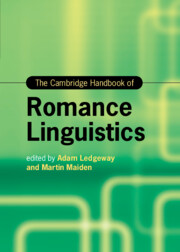Book contents
- The Cambridge Handbook of Romance Linguistics
- Cambridge Handbooks in Language and Linguistics
- The Cambridge Handbook of Romance Linguistics
- Copyright page
- Dedication
- Contents
- Figures
- Tables
- Contributors
- Abbreviations
- 1 Data, Theory, and Explanation: The View from Romance
- Part One What Is a Language?
- Part Two Phonetics and Phonology
- 5 Structure of the Syllable
- 6 Sandhi Phenomena
- 7 Effects of Stress
- 8 The Notion of the Phoneme
- 9 Typologically Exceptional Phenomena in Romance Phonology
- Part Three Morphology
- Part Four Syntax
- Part Five Semantics and Pragmatics
- Part Six Language, Society, and the Individual
- Index
- References
7 - Effects of Stress
from Part Two - Phonetics and Phonology
Published online by Cambridge University Press: 23 June 2022
- The Cambridge Handbook of Romance Linguistics
- Cambridge Handbooks in Language and Linguistics
- The Cambridge Handbook of Romance Linguistics
- Copyright page
- Dedication
- Contents
- Figures
- Tables
- Contributors
- Abbreviations
- 1 Data, Theory, and Explanation: The View from Romance
- Part One What Is a Language?
- Part Two Phonetics and Phonology
- 5 Structure of the Syllable
- 6 Sandhi Phenomena
- 7 Effects of Stress
- 8 The Notion of the Phoneme
- 9 Typologically Exceptional Phenomena in Romance Phonology
- Part Three Morphology
- Part Four Syntax
- Part Five Semantics and Pragmatics
- Part Six Language, Society, and the Individual
- Index
- References
Summary
This chapter deals with phonological and morpho-lexical phenomena in Romance that are conditioned by prominence or – more generally speaking – metrical structure. Relevant in this respect are synchronic phonological effects on surface forms, in other words, systematic alternations, as well as diachronic effects on underlying representations, that is, on linguistic inventories and systems. Among the phonological effects of prominence treated here are lengthening, well-attested in Italian, and diphthongization of stressed vowels – found in most Romance languages. Of equal interest are effects of non-prominence, such as vowel aphaeresis, apocope and syncope, and vowel reduction. As to phenomena conditioned by constraints on metrical well-formedness, considered here as effects of stress, the chapter deals with the Italo-Romance type of consonant gemination, as well as compensatory lengthening more generally. Adjacent stresses may be subject to clash resolution, a phenomenon that has been described for some, but not all, Romance languages. In the realm of morphophonology, alternations of the verb root often depend on the position of stress, which is particularly evident for diphthongization. The chapter ends with a discussion of how metrical structure shapes the form of words, imposing requirements on the minimal size of lexical entries.
Keywords
- Type
- Chapter
- Information
- The Cambridge Handbook of Romance Linguistics , pp. 234 - 260Publisher: Cambridge University PressPrint publication year: 2022

